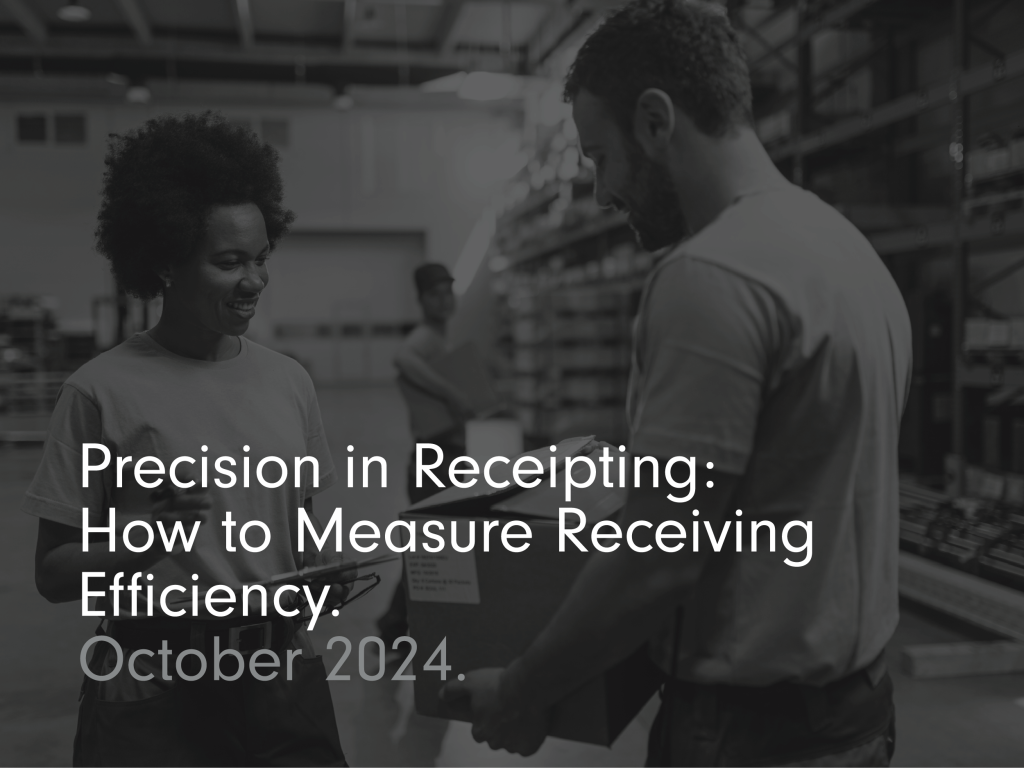Precision in Receipting: How to Measure Receiving Efficiency.

In logistics, ensuring receipt accuracy is paramount. For logistics managers striving to optimise operations, understanding and improving receipt accuracy can lead to significant savings and enhanced efficiency. In this guide, we’ll explore receipt accuracy. We’ll define what it means and provide practical steps for measuring and improving it.
Understanding Receipting Meaning
First, let’s explain what receipting means in logistics. It’s when we record and confirm goods arriving at a warehouse. This involves checking that the items received match the orders in both quantity and quality.
Accurate receipting is an important part of the supply chain. It makes sure the right goods are ready for distribution, preventing delays or mistakes. This keeps your inventory data reliable and helps improve warehouse management and efficiency.

How to Calculate Accuracy
Calculating accuracy in logistics is essential for maintaining data integrity and making informed decisions. Here’s a straightforward way to calculate receipt accuracy:
1. Define the Scope: Identify the total number of orders received and the number of orders received accurately.
2. Apply the Formula:
Receipt Accuracy = (Total number of accurate orders / Total number of orders received) × 100
3. Analyse Trends: Regularly track this metric to identify patterns and potential areas for improvement.
Defining Accuracy Rate Meaning
The accuracy rate in logistics is an important measurement that shows how well your receiving process works. It shows the percentage of goods correctly received compared to the total number received.
A high accuracy rate means you have strong receiving processes, effective stock count, and good supply chain management. A low rate shows areas that need improvement.
How to Measure Data Accuracy
Data accuracy is crucial for warehouse management, from counting stock to fulfilling orders. To measure it, do regular audits with cycle and physical counts to check inventory records. Use technology by adopting advanced warehouse systems to automate data capture and cut manual errors. Also, quickly find and fix any discrepancies to keep data quality high.

Measuring Receiving Efficiency
Receiving efficiency is an important measure for logistics managers. This metric examines how quickly and accurately workers unload, verify, and stock goods. To measure this, track the total time it takes to receive and process each batch of goods.
Calculate how many items each worker processes per hour using the required data points. Use this data to find and fix any slowdowns in the workflow. This will lead to faster receiving times and better efficiency overall, ultimately reducing carrying costs.
Data capture makes receiving more accurate and faster. Tools like barcode scanners or RFID tags help prevent mistakes, saving time and reducing errors. An accuracy formula measures the precision of receiving by checking the balance between true positive and true negative results. It also considers data points, total time, carrying costs, and required data.
Even with automation, mistakes can still occur during receiving. It’s important to have a system to find and fix these errors quickly. This keeps the data accurate and up-to-date, ensuring good inventory management.
Besides accuracy, it’s important for logistics managers to measure receiving efficiency. This helps them assess how well customers receive goods.
Benefits of High Receipt Accuracy
Achieving high receipt accuracy offers several benefits:
- Reduced Costs: Minimise errors and rework, leading to significant cost savings.
- Enhanced Data Quality: Maintain accurate inventory records to support better decision-making.
- Improved Customer Satisfaction: Ensure timely and accurate order fulfilment, boosting customer trust and loyalty. Increased Efficiency: With fewer errors and streamlined workflows, employees can work more effectively and efficiently.
- Faster Processing Times: High receipt accuracy enables quick receiving and processing of goods. This reduces wait times for customers.
- Better Inventory Management: Keeping accurate records of inventory levels helps ensure the right products are in stock when needed. This prevents costly shortages or overstocking.
- Reduced Risk of Loss or Theft: Accurately tracking all received goods greatly reduces the risk of loss or theft.
Overall, investing time and resources into achieving high receipt accuracy can lead to significant improvements in operations and customer satisfaction. It allows businesses to operate more smoothly, reduce costs, and provide better service to their customers.

Setting Accuracy Goals
To get high receipt accuracy, it’s important to set clear goals that can be measured. Decide on a target accuracy rate, like 99%, and plan the steps to reach this goal. Check and adjust your targets often based on the data you collect. This keeps your team motivated and focused on getting better at accuracy.
Implementing Quality Control Processes
Quality control must happen throughout the receiving process to ensure accuracy. Check purchase orders, inspect goods for damage, and record all items properly. Random checks also catch mistakes or differences that you might miss.
Using Technology for Accuracy
Using technology like barcode scanners and inventory software can improve how accurate receipts are. These tools help automate data entry and reduce mistakes. They also show real-time inventory levels, making it easier to track and manage stock correctly.
Leveraging Technology for Accuracy
Advanced technologies can significantly enhance receipt accuracy:
Barcode Scanners: Automate data entry, reducing manual errors.
RFID Tags: Track items in real-time, providing precise inventory data.
Warehouse Management Systems (WMS): Integrate with your ERP system to streamline operations and enhance data quality.

What is Inventory Receipt?
In the supply chain, warehouses take in and record inventory. This step is important. It involves checking items and their quality against purchase orders.
Accurate inventory records keep stock levels correct. This helps operations run smoothly and makes managing inventory easier. Automating this process reduces mistakes.
Accurate inventory receipt strengthens the supply chain. It helps businesses adjust to market changes. Real-time tracking gives important data for decisions.
Role of Warehouse Management Systems (WMS)
Warehouse Management Systems (WMS) are essential for managing inventory receipt. They help streamline operations.
WMS can integrate with Enterprise Resource Planning (ERP) systems. This allows different departments to communicate smoothly. It also ensures data accuracy in all business functions.
Integration of WMS and ERP Systems
Integrating WMS with ERP systems helps businesses view their inventory from receiving to shipping in one place. This real-time visibility is crucial for making smart decisions and keeping stock levels efficient.

Optimising Receiving Cycle Time in Inventory Management Systems
Reducing the receiving cycle time is important for better inventory management. This cycle time tracks the period from when the warehouse receives goods to when they store and prepare them for picking.
Shortening the cycle time helps get inventory into the system faster. This improves customer service, lowers holding costs, and increases inventory turnover.
Automated solutions, like advanced warehouse management systems (WMS), make processes easier. They speed up data capture. They also help with verification and inventory updates.
Integrating real-time analytics helps find bottlenecks in processes. This leads to ongoing improvements and better use of resources.
Technology can reduce receiving cycle time, boosting speed. It also makes the entire supply chain stronger. This helps businesses quickly adapt to market demands.
Conclusion
Receipt accuracy is crucial for efficient supply chain management. It’s more than just a metric. Knowing how to calculate and measure accuracy is important.
With advanced technology and automated solutions, businesses can streamline their processes. This helps them reduce errors and stay ahead of the competition.
By investing in tools like warehouse management systems and real-time analytics, companies can improve receipt accuracy. This helps drive success in today’s competitive marketplace.
Frequently Asked Questions.
Receipt accuracy ensures that inventory records are correct, reducing errors and rework, and enhancing overall supply chain efficiency.
Implement best practices such as vendor collaboration, employee training, and technology integration to reduce errors and improve accuracy.
Challenges include human error, supplier issues, and managing complex supply chains. Regular audits and continuous process optimization can help mitigate these issues.
Technologies such as barcode scanners, RFID tags, and warehouse management systems help automate data capture. They reduce manual errors and offer real-time inventory data.
Benefits include reduced costs, enhanced data quality, improved customer satisfaction, and more efficient supply chain operations.
Receipting is when you record and check if the goods or services you received match the order and payment. This step is important in managing the supply chain. It keeps accurate inventory and financial records.